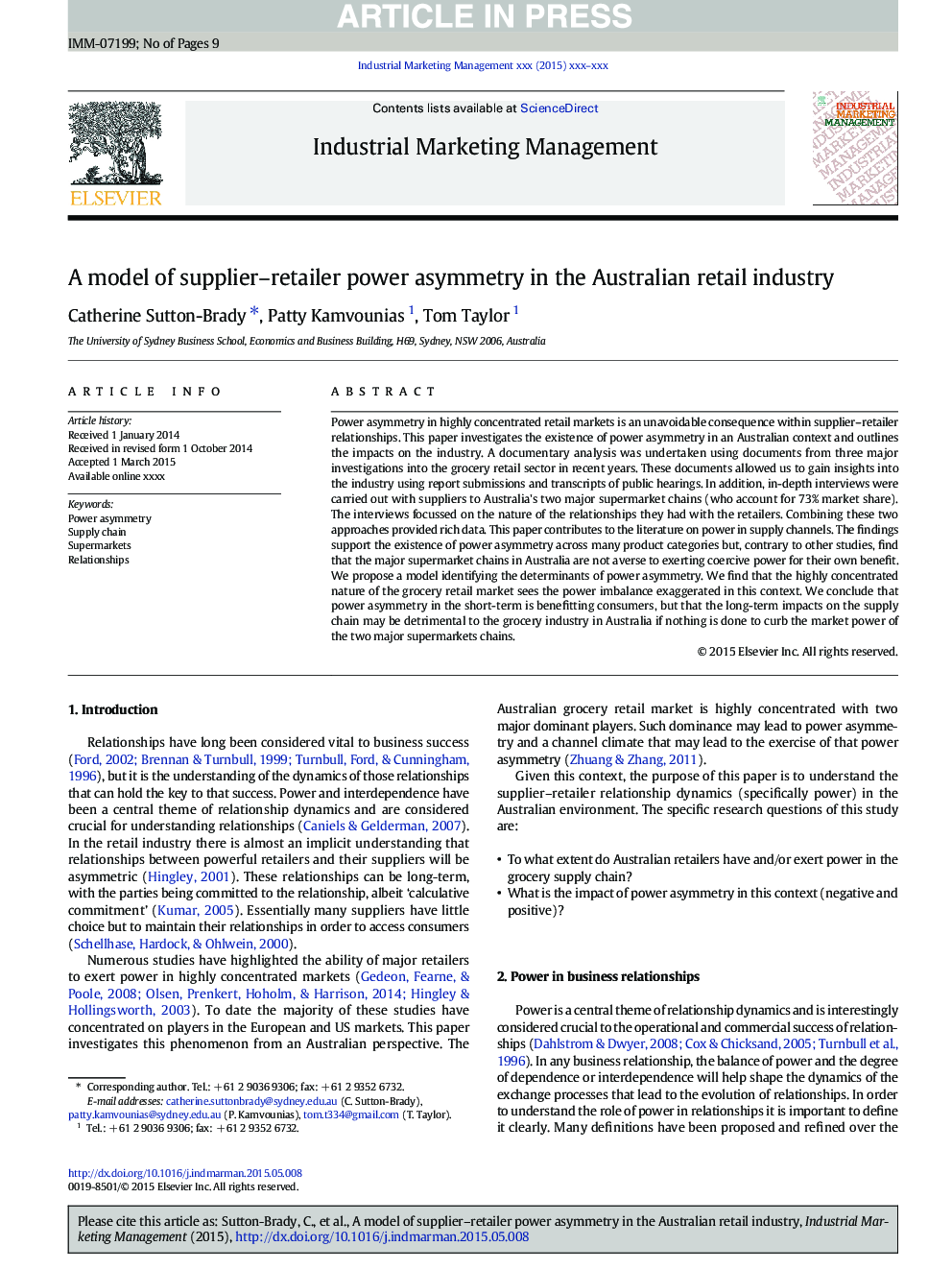| کد مقاله | کد نشریه | سال انتشار | مقاله انگلیسی | نسخه تمام متن |
|---|---|---|---|---|
| 7432616 | 1483451 | 2015 | 9 صفحه PDF | دانلود رایگان |
عنوان انگلیسی مقاله ISI
A model of supplier-retailer power asymmetry in the Australian retail industry
ترجمه فارسی عنوان
یک مدل تقارن قدرت فروش خرده فروشان در صنعت خرده فروشی استرالیا
دانلود مقاله + سفارش ترجمه
دانلود مقاله ISI انگلیسی
رایگان برای ایرانیان
کلمات کلیدی
عدم تقارن قدرت، زنجیره تامین، سوپر مارکت ها، روابط،
ترجمه چکیده
نامتقارن برق در بازارهای خرده فروشی بسیار متمرکز پیامد اجتناب ناپذیری در روابط فروشندگان و فروشندگان است. این مقاله به بررسی وجود عدم تقارن قدرت در یک زمینه استرالیا و بررسی تاثیرات آن بر صنعت می پردازد. تجزیه و تحلیل مستند با استفاده از اسناد از سه تحقیق عمده در بخش خرده فروشی مواد غذایی در سال های اخیر انجام شد. این اسناد به ما اجازه دادند بینش های صنعت را با استفاده از گزارش های ارائه شده و رونویسی از جلسات عمومی به دست آورد. علاوه بر این، مصاحبه های عمیق با تامین کنندگان به زنجیره های بزرگ سوپر مارکت استرالیا (که 73 درصد سهم بازار را تشکیل می دهند) انجام شد. مصاحبه ها بر ماهیت روابط آنها با خرده فروشان تمرکز داشتند. ترکیب این دو رویکرد داده های ثروتمند را فراهم کرد. این مقاله به ادبیات در مورد قدرت در کانال های عرضه کمک می کند. یافته ها حاکی از عدم تقارن قدرت در میان بسیاری از دسته بندی های محصول را پشتیبانی می کند، اما بر خلاف سایر مطالعات، متوجه می شود که عمده زنجیره های سوپرمارکت در استرالیا در تلاش برای اعمال قدرت اجباری به نفع خود نیستند. ما یک مدل تعیین کننده عوامل تعیین کننده عدم تقارن قدرت را پیشنهاد می کنیم. ما دریافتیم که طبیعت بسیار متمرکز بازار خرده فروشی مواد غذایی، عدم تعادل قدرت را در این زمینه اغراق می کند. ما نتیجه می گیریم که عدم تقارن قدرت در کوتاه مدت از مصرف کنندگان سود می برد، اما تاثیرات بلندمدت در زنجیره تامین ممکن است برای صنعت مواد غذایی در استرالیا زیان آور باشد، اگر هیچ کاری برای محدود کردن قدرت بازار دو زنجیره عمده سوپرمارکت ها انجام نشود.
موضوعات مرتبط
علوم انسانی و اجتماعی
مدیریت، کسب و کار و حسابداری
بازاریابی و مدیریت بازار
چکیده انگلیسی
Power asymmetry in highly concentrated retail markets is an unavoidable consequence within supplier-retailer relationships. This paper investigates the existence of power asymmetry in an Australian context and outlines the impacts on the industry. A documentary analysis was undertaken using documents from three major investigations into the grocery retail sector in recent years. These documents allowed us to gain insights into the industry using report submissions and transcripts of public hearings. In addition, in-depth interviews were carried out with suppliers to Australia's two major supermarket chains (who account for 73% market share). The interviews focussed on the nature of the relationships they had with the retailers. Combining these two approaches provided rich data. This paper contributes to the literature on power in supply channels. The findings support the existence of power asymmetry across many product categories but, contrary to other studies, find that the major supermarket chains in Australia are not averse to exerting coercive power for their own benefit. We propose a model identifying the determinants of power asymmetry. We find that the highly concentrated nature of the grocery retail market sees the power imbalance exaggerated in this context. We conclude that power asymmetry in the short-term is benefitting consumers, but that the long-term impacts on the supply chain may be detrimental to the grocery industry in Australia if nothing is done to curb the market power of the two major supermarkets chains.
ناشر
Database: Elsevier - ScienceDirect (ساینس دایرکت)
Journal: Industrial Marketing Management - Volume 51, November 2015, Pages 122-130
Journal: Industrial Marketing Management - Volume 51, November 2015, Pages 122-130
نویسندگان
Catherine Sutton-Brady, Patty Kamvounias, Tom Taylor,
